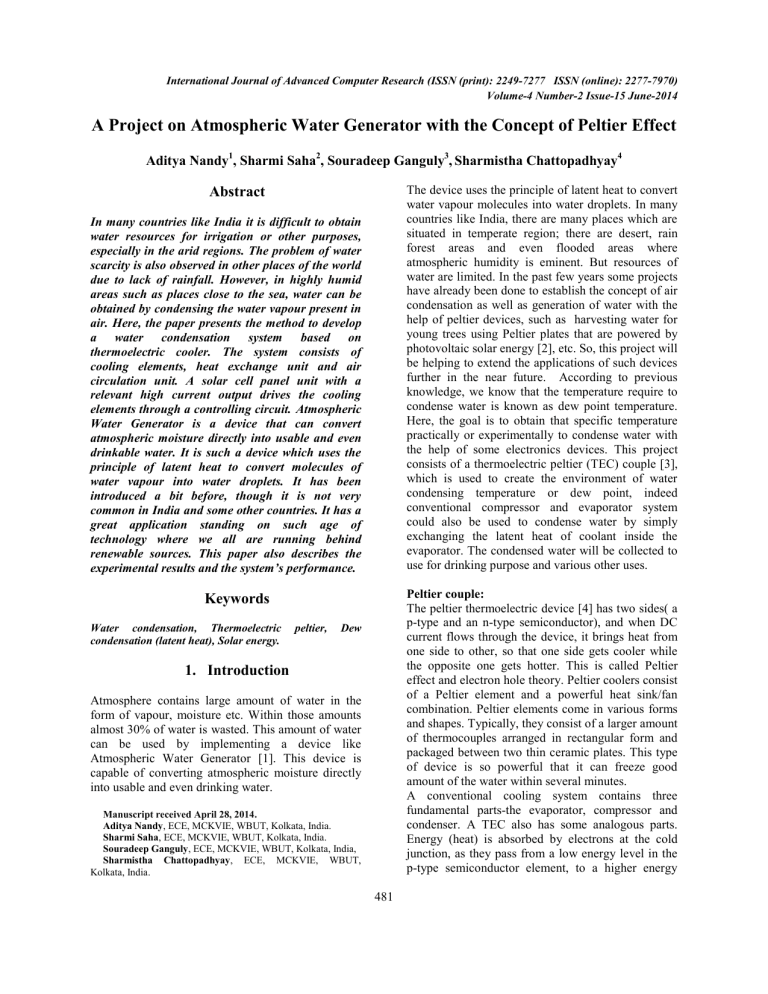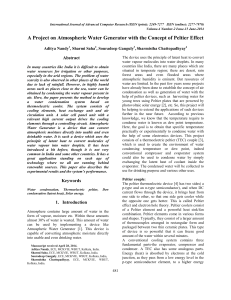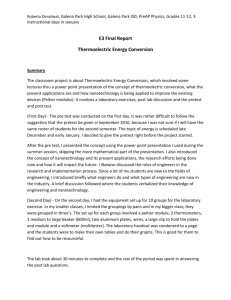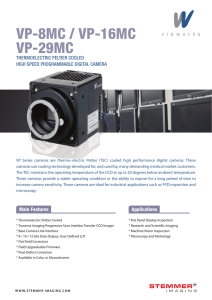
International Journal of Advanced Computer Research (ISSN (print): 2249-7277 ISSN (online): 2277-7970) Volume-4 Number-2 Issue-15 June-2014 A Project on Atmospheric Water Generator with the Concept of Peltier Effect Aditya Nandy1, Sharmi Saha2, Souradeep Ganguly3, Sharmistha Chattopadhyay4 The device uses the principle of latent heat to convert water vapour molecules into water droplets. In many countries like India, there are many places which are situated in temperate region; there are desert, rain forest areas and even flooded areas where atmospheric humidity is eminent. But resources of water are limited. In the past few years some projects have already been done to establish the concept of air condensation as well as generation of water with the help of peltier devices, such as harvesting water for young trees using Peltier plates that are powered by photovoltaic solar energy [2], etc. So, this project will be helping to extend the applications of such devices further in the near future. According to previous knowledge, we know that the temperature require to condense water is known as dew point temperature. Here, the goal is to obtain that specific temperature practically or experimentally to condense water with the help of some electronics devices. This project consists of a thermoelectric peltier (TEC) couple [3], which is used to create the environment of water condensing temperature or dew point, indeed conventional compressor and evaporator system could also be used to condense water by simply exchanging the latent heat of coolant inside the evaporator. The condensed water will be collected to use for drinking purpose and various other uses. Abstract In many countries like India it is difficult to obtain water resources for irrigation or other purposes, especially in the arid regions. The problem of water scarcity is also observed in other places of the world due to lack of rainfall. However, in highly humid areas such as places close to the sea, water can be obtained by condensing the water vapour present in air. Here, the paper presents the method to develop a water condensation system based on thermoelectric cooler. The system consists of cooling elements, heat exchange unit and air circulation unit. A solar cell panel unit with a relevant high current output drives the cooling elements through a controlling circuit. Atmospheric Water Generator is a device that can convert atmospheric moisture directly into usable and even drinkable water. It is such a device which uses the principle of latent heat to convert molecules of water vapour into water droplets. It has been introduced a bit before, though it is not very common in India and some other countries. It has a great application standing on such age of technology where we all are running behind renewable sources. This paper also describes the experimental results and the system’s performance. Peltier couple: The peltier thermoelectric device [4] has two sides( a p-type and an n-type semiconductor), and when DC current flows through the device, it brings heat from one side to other, so that one side gets cooler while the opposite one gets hotter. This is called Peltier effect and electron hole theory. Peltier coolers consist of a Peltier element and a powerful heat sink/fan combination. Peltier elements come in various forms and shapes. Typically, they consist of a larger amount of thermocouples arranged in rectangular form and packaged between two thin ceramic plates. This type of device is so powerful that it can freeze good amount of the water within several minutes. A conventional cooling system contains three fundamental parts-the evaporator, compressor and condenser. A TEC also has some analogous parts. Energy (heat) is absorbed by electrons at the cold junction, as they pass from a low energy level in the p-type semiconductor element, to a higher energy Keywords Water condensation, Thermoelectric condensation (latent heat), Solar energy. peltier, Dew 1. Introduction Atmosphere contains large amount of water in the form of vapour, moisture etc. Within those amounts almost 30% of water is wasted. This amount of water can be used by implementing a device like Atmospheric Water Generator [1]. This device is capable of converting atmospheric moisture directly into usable and even drinking water. Manuscript received April 28, 2014. Aditya Nandy, ECE, MCKVIE, WBUT, Kolkata, India. Sharmi Saha, ECE, MCKVIE, WBUT, Kolkata, India. Souradeep Ganguly, ECE, MCKVIE, WBUT, Kolkata, India, Sharmistha Chattopadhyay, ECE, MCKVIE, WBUT, Kolkata, India. 481 International Journal of Advanced Computer Research (ISSN (print): 2249-7277 ISSN (online): 2277-7970) Volume-4 Number-2 Issue-15 June-2014 level in the n-type semiconductor element. It is the power supply that provides the energy to make those electrons to move through the system. At the hot junction, energy is expelled to a heat sink as electrons move from a high energy level element (n-type) to a lower energy level element (p-type). The ratio of QC to P is the heat absorbed at the cold junction, divided by the input power i.e. QC / P is known as COP [5] which is often used to pick out better device. Advantages of this device over conventional device: There are lot of advantages of TEC over the conventional refrigeration system. No moving part, so maintenance is required less frequently. No use of chlorofluorocarbons. Temperature control within fractions of degrees can be maintained. Flexible shape (form factor); in particular, they can have a very small size. Ideal for modern technology trends. Can be used in environments that are smaller or more severe than conventional refrigeration. Has a long life, with mean time between failures (MTBF) exceeding almost 100,000 hours. Controllable via changing the input voltage/current very easily. Draw comparatively low current than a compressor based refrigeration system. 2. Working Features Practically TE couples are combined in a module, connected electrically in series and thermally in parallel to obtain a promising output. But it will be inconvenient to use such a device that has less advantageous work done to power ratio. There are modules available in the market according to variety of sizes, shapes, operating voltages-currents and ranges of heat pumping capacity. The present trend, however, is towards a larger number of couples operating at lower currents; before choosing an efficient device, some parameters must be determined. These are: TC: Temperature at Cold Surface. TH: Temperature at Hot Surface. This TH incorporates two major parameters: 1. The efficiency of the device i.e. between the hot surface of the TEC and the ambient environment. 2. The temperature of ambient environment into which the heat is being rejected. QC: The heat to be absorbed at the Cold Surface. The object to be cooled is intimately confined with the cold surface of TEC, thus the temperature of that object starts falling until it is as same as the temperature of the cold surface of the TEC. Now, ∆T can be defined as: ∆T = TH - TC (1) This conflict should be accurately determined if the design is to operate as desired. Figure 2: Working of Peltier Device System assembly: The matter of the performance is to be accomplished when this device is kept within a comparatively humid environment and air is pushed towards the cooler side of TEC device, so that the water vapour gains its latent heat, required for the dew point temperature and thus water condensation takes place; this process can be enhanced if same hot air is passed Figure 1: Overview of peltier device 482 International Journal of Advanced Computer Research (ISSN (print): 2249-7277 ISSN (online): 2277-7970) Volume-4 Number-2 Issue-15 June-2014 through the cold side of TEC, so that water droplets doesn’t form ice and generation of water takes place. It is imperative to keep in mind the purpose of the assembly, so the technique to be used is as important as the selection of the proper device. All of the mechanical interfaces assembled within the objects are to be cooled as well as the ambient. It’s quite natural that all thermal-mechanical interfaces tend to inhibit the flow of heat by adding thermal resistance. The consideration of assembly techniques should be highly optimized to minimize thermal resistance. Mechanical tolerances of heat exchanger [6] surfaces should never surpass 0.001 in/in with a ceiling of 0.002" of total Indicated Reading. When it is essential to use more than one module between common plates, the variation of height between modules, it should not go beyond 0.001"(request tolerance lapped modules when ordering). Generally most TE assemblies make use of "thermal grease" interfaces. The thickness of the grease should be limited to 0.003 ± 0.0006" [7]. In order to incorporate these types of tolerances, certain levels of cleanliness must be maintained; as grease has high affinity to such pollutant elements like dirt, grit, and toxic powder of Sulphur, Carbon compounds etc., and these elements can increase the level of impurity inside the water pouring from the adjacent places of grease joints. Figure 4: Simplest theoretical design of TEC assembly Solar-driven thermoelectric: Solar energy has the excellent advantage of low water consumption during its use-phase [8], thus it ideal for installation in places where there is a high degradation of freshwater supply. However, utilization of solar refrigeration would have been still excluded if the energy crisis in 1970s did not affect the modern thoughts [9]. Research on Peltier’s cooling effect and Photovoltaic effect also developed around that time, primarily for the cold chain project of the World Health Organization and the international Health Organizations specifically for rural areas [10]. Solar cells were used inside small TE operated fridges. Experimental investigation and analysis on a solar cell driven thermoelectric refrigerator has been conducted [11]. The main components of the solar battery consist of cell including the (Photo Voltaic) PV array, the storage battery and the controller. The PV array is installed at outdoors and the battery stores the excess, produced during sunshine periods. This stored energy is further used for running the system during the night hours also. The controller is mainly an electronic device, assembled with microprocessor, which can readily sense the battery condition as well as the power consumptions and controls the system operation accordingly. It has very simple architecture or circuit design. The main duty of it is to protect the battery against excessive charging or discharging. There are specially designed lead-acid batteries suitable for deep discharge cycles occurring in systems indeed this battery could be any type. Figure 3: Schematic Diagram of System Assembly for Drinking Water 483 International Journal of Advanced Computer Research (ISSN (print): 2249-7277 ISSN (online): 2277-7970) Volume-4 Number-2 Issue-15 June-2014 comparatively it’s fruitful to use TEC1 though it takes a bit longer time to run efficiently. Required calculations and equations: One of the objectives from the very first of this project is to obtain dew point temperature and control of the temperature in order to use the exact energy to condense water, a precise control of the temperature of the cold side must be performed. The equation is [2]: Tdp = (Hr/100)1/8.(112+0.9Ta) +0.1T a -112 (2) Where Tdp (ºC) is the dew point temperature, Hr (%) is relative humidity and Ta (ºC) is the temperature of the ambient air moisture that is to be condensed, i.e. the air in the cold chamber (shown in the diagram). TEC1 is typically connected side by side and sandwiched between two ceramic plates. The cooling ability of this type of device is then proportional to the number of TEC1s in it. The amount of heat that can be absorbed is proportional to the current and time. W= P.I.t (3) Here P is the Peltier Coefficient, I is the current, and t is time [12]. These two mathematical expressions will be sufficient for this prototype project to be carried on further. 3. Equipments and Result The solar cell unit is to be installed in this system, rated as output of 12 V with the maximum output power of 120 W, evidently which is able to supply enough power to keep running three 40 W (3.5 A) Peltier coolers (TEC1) connected in parallel. The Peltier device has a dimension of 4x4x0.8 cm. The maximum temperature difference i.e. ∆T of 87°C. A 3000rpm, 15x15cm (size of TEC1) fan that is capable of producing airflow of at most 500 cfm is used for circulation of the air. The heat sinks are made of aluminium and anodized. Activated carbon filter are used for water filtration. Two temperature sensors and a PIC16F872 or ATmega series microcontroller can be used for temperature control. Explanation of AWG: Air capacity of holding water-vapour varies according to the temperature of the air and humidity. The warmer the air, the more water-vapour it can hold. The moisture air is pumped first into the tube thus the cold side of the Peltier element helps to decrease the air temperature. Working of the device: According to the previous elaboration, the objective is to calculate the dew point temperature Tdp from the gathered information about that ambient environment into which the device is going to run i.e. the information regarding Hr and Ta. Once the dew point temperature is obtained, the peltier coefficient P and the current rating of the device (TEC1) can also be obtained from device data table; thus the estimated time for generating water droplets from the humid air is calculated readily. As soon as the device is powered the hot side starts getting hotter and cold side cooler; reaching the dew point temperature. The cold side of TEC starts to cool the air passing through its heat sink area and water vapours start to condense just like the water condensation happens outside a glass full of ice. It is important to keep in mind that when TEC starts it takes a longer time to actually produce water, though it reaches the dew point temperature readily, but after some time the process acquires the speed to produce sufficient water according to the experiment result of this project. TEC1 is a device that is used for average efficiency requirement according to the power is fed and time taking to reach its optimum level of cooling effect. As this project mainly lies on the uses of solar energy, it is immediately not possible to use higher TEC as those will require higher voltage rating. So Figure 5: Project design of Atmospheric Water Generator 484 International Journal of Advanced Computer Research (ISSN (print): 2249-7277 ISSN (online): 2277-7970) Volume-4 Number-2 Issue-15 June-2014 So, as the air cools down, its capacity of holding water decreases and water moisture starts condensing. The air is then passed through to the hotter side of TEC that cools the temperature of hot side, as shown in above diagram. This is necessary to keep running of peltier device; otherwise the temperature will increase at hot side so much that the device could be damaged. This warm air can be sent to the cooler side to increase the water generation, as described earlier. The condensed water falls into a reservoir then passes through a filter (optional). encounters higher power solar cells and also has the adroitness to store the excess energy during the day light that is to be used at night; indeed the economical advantage of this kind of system is a bit obscure due to the relatively high installation cost. This idea can be extended further in future – 1) For large scale implementation, RO and UV water filter can be used for producing such water that meets the standard of WHO and BIS easily. 2) Peltier device has many types of models which are much efficient than TEC1. Those can be used. 3) As the project aims at producing water from atmosphere and keeping this device handy, large sized scrubbers are not used for better air filtration. Scrubbers can remove all the oxides from the air. For large implementation it can be handled. 4) The concept of this project can also be used as a better alternative in refrigeration science against conventional systems. It can also be observed in this way i.e. the usage of such low power semiconductor devices are indicating towards more prominent evolution of cooling engineering that is going to alter the whole scenario and myths about the power consumption of refrigeration science. Thus in near future we will be able to use such devices that are now limited within the project works. When testing an assembly of this type it is important to monitor temperature and relative humidity. Measuring the temperature and the humidity of the cooling inlet and outlet air as well as flow rates is necessary to build a closed loop control unit. It is built using TC1046 Sensor and a PIC16F872 or ATmega series microcontroller to control the system and keeping the temperature of the circulating air above the water freezing point. It senses the temperature of two sides of TEC1 by using two temperature sensors and accordingly follows an algorithm to control the fan’s speed as well as system safety. According to the output, and a bit estimation it is observed that, this system can produced almost 1 Litre of condensed water per hour during the day light, when it is running at its optimum working condition. References [1] Greg M.Peters; Naomi J.Blackburn; Michael Armedion, "Environmental assessment of air to water machines-triangulation to manage scope uncertainity", Springer-Vsuccumbed Berlin Ileidelberg 2013, vol 18, pp. 1149-1157, 27 March, 2013. [2] M.A.Muñoz-García; Miguel Angel; Moreda Cantero; P.Guillermo; M.P.Raga Arroyo; Manuela Pilar; Marín González; Omar (2013). Water harvesting for young trees using Peltier modules powered by photovoltaic solar energy. "Computers and Electronics in Agriculture", v. 93; pp. 60 - 67. [3] R.A.Taylor; G.L.Solbrekken, "Comprehensive system-level optimization of thermoelectric devices for electronic cooling applications," Components and Packaging Technologies, IEEE Transactions on, vol.31, no.1, pp.23-31, March 2008. [4] H.Morimitsu; E.Saito; S.Katsura, "An approach for heat flux sensor-less heat inflow estimation based on distributed parameter system of Peltier device," IECON 2011 - 37th Annual Conference on IEEE Industrial Electronics Society , vol., no., pp.4214-4219, 7-10 Nov. 2011. 4. Applications There are hardly any chances to refuse that this device is portable for its simple design and endurance capability. So, the Atmospheric Water Generator is the device which can be implemented for extreme situation, to use during flood, in desert areas, and in rural areas. It has great advantages as it works like a renewable source of atmosphere water and doesn’t need a heavy power source. Many company like ‘Watermaker India ltd’, ‘Aerowater’, etc have already this type of device for domestic purpose. It can be implemented for Industrial development where the water is a matter of crisis. 5. Conclusion and Future Work Applying this system in a highly humid region almost 1 Litre of condensed water can be produced per hour during the day light, this is a promising result; then a more enhanced system can be designed that 485 International Journal of Advanced Computer Research (ISSN (print): 2249-7277 ISSN (online): 2277-7970) Volume-4 Number-2 Issue-15 June-2014 Aditya Nandy, born on 20th June 1991, is pursuing B.tech in Electronics and Communication and is a pre final year student of MCKV Institute of Engineering under West Bengal University of Technology (WBUT). His interests lie in the field of Wireless Communication, Aerospace and Domestic Robotics. [5] Chakib Alaoui, "Peltier Thermoelectric Modules Modeling and Evaluation", International Journal of Engineering (IJE), Volume (5): Issue (1):2011. [6] N.Kammuang-lue; P.Sakulchangsatjatai; P.Terdtoon, "Effect of working fluids on thermal characteristic of a closed-loop pulsating heat pipe heat exchanger: A case of three heat dissipating devices," Electronics Packaging Technology Conference (EPTC), 2012 IEEE 14th, vol., no., pp.142-147, 5-7 Dec. 2012. [7] S.N.Paisner; M.Touzelbaev; G.Refai-Ahmed; Yizhang Yang, "New developments for a nopump-out high-performance thermal grease," Thermal and Thermo mechanical Phenomena in Electronic Systems (ITherm), 2010 12th IEEE Intersociety Conference on, vol., no., pp.1-4, 2-5 June 2010. [8] B.Singh; L.Tan; A.Date; A.Akbarzadeh, "Power generation from salinity gradient solar pond using thermoelectric generators for renewable energy application," Power and Energy (PECon), 2012 IEEE International Conference on , vol., no., pp.89-92, 2-5 Dec. 2012. [9] D.D.L.Wijngaards; R.F.Wolffenbuttel, "Study on temperature stability improvement of on-chip reference elements using integrated Peltier coolers," Instrumentation and Measurement, IEEE Transactions on, vol.52, no.2, pp.478-482, April 2003. [10] Mu Zhijun; Wang Dianhua; Guan Xin, "Design and Study on Small Solar Energy Photovoltaic Hot Water System," Power and Energy Engineering Conference (APPEEC), 2011 AsiaPacific, vol., no., pp.1-4, 25-28 March 2011. [11] R.Sharma; V.K.Sehgal; Nitin; A.Thakur; A.M.Khan; A.Sharma; Pankaj Sharma, "Peltier Effect Based Solar Powered Air Conditioning System," Computational Intelligence, Modelling and Simulation, 2009. CSSim '09. International Conference on, vol., no., pp.288-292, 7-9 Sept. 2009. [12] J.Garrido; A.Casanovas, "The central role of the Peltier coefficient in thermoelectric cooling," Journal of Applied Physics, vol.115, no.12, pp.123517-123517-6, Mar 2014. Sharmi Saha, born on 18th August 1992, is pursuing B.tech in Electronics and Communication and is a pre final year student of MCKV Institute of Engineering under West Bengal University of Technology (WBUT). Her interests lie in the field of Wireless Communication. Souradeep Ganguly, born on 17th May 1991,is pursuing Btech in Electronics and Communication and is a Final Year student of MCKV Institute of Engineering under West Bengal University of Technology(WBUT).His interests lies in the field of VLSI Design,Robotics and Embedded System Design. Sharmistha Chattopadhyay, born on 13th June 1992,is pursuing Btech in Electronics and Communication and is a Final Year student of MCKV Institute of Engineering under West Bengal University of Technology(WBUT).Her interests lies in the field of VLSI Design,Robotics and Embedded System Design. Author’s Photo 486 Reproduced with permission of the copyright owner. Further reproduction prohibited without permission.






